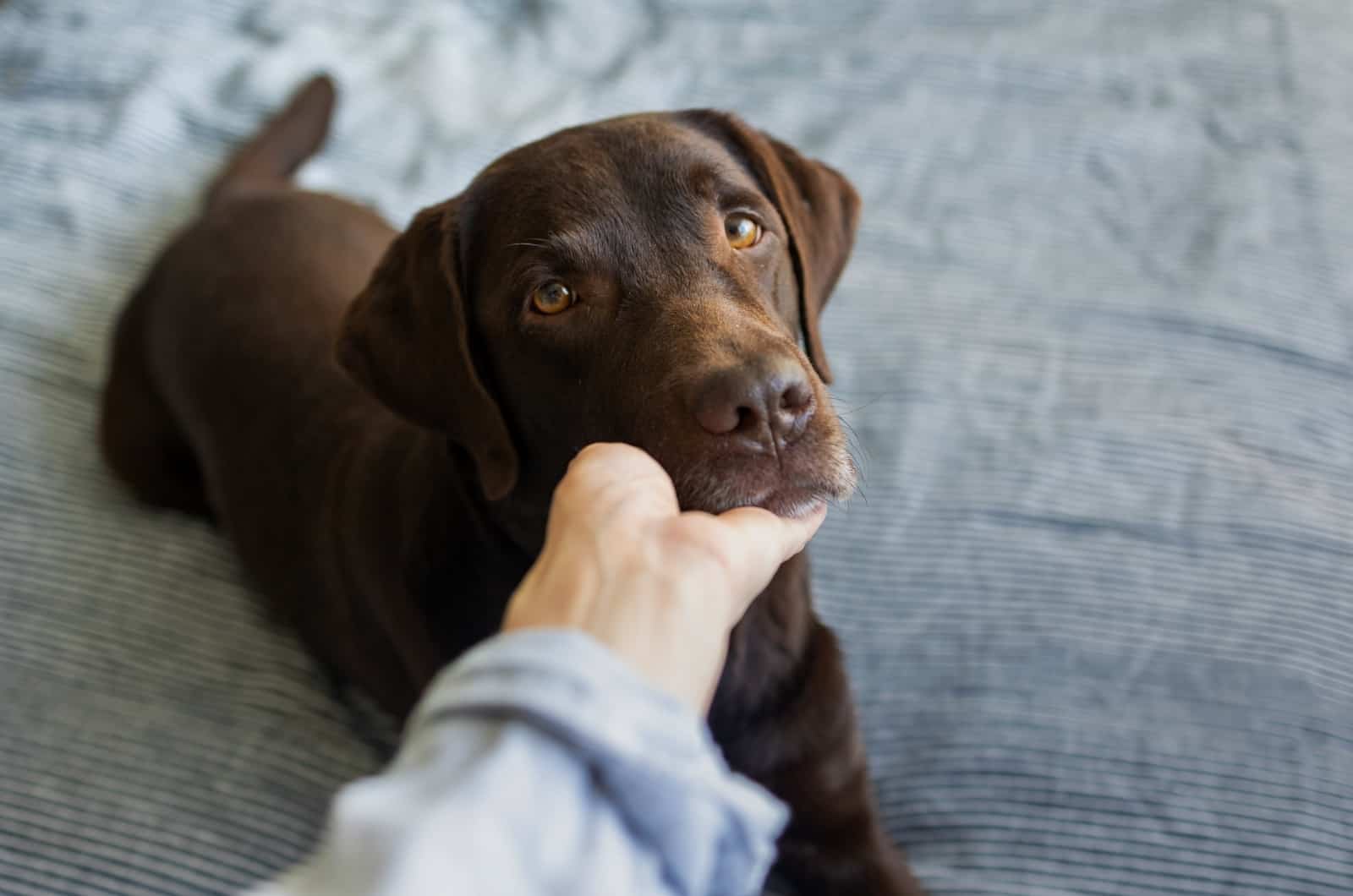Labrador hip problems are hereditary issues that affect quite a lot of these pups. In fact, studies show that a whopping 36.76% of all hip problem cases were found in this breed. But the trouble doesn’t stop there, good boys seem to be more affected with this issue, with 59.55% of cases.
And just when we thought it couldn’t get any worse, it turns out bilateral hip problems such as hip dysplasia was the most common form, affecting a staggering 88.60% of all cases.
Now that we got that out of the way, let’s discuss the 7 most common hip issues Labradors face, their common symptoms, and the best ways to treat them.
7 Labrador Hip Problems And Their Symptoms

Taking into consideration that the breed-wise incidence of hip problems is more common in Labrador Retrievers than in any other breed, it is important to pay attention to all the symptoms and signs your pup might be showing.
Let’s dive into the world of skeletal problems of these big dogs!
1. Hip Dysplasia
Labrador hip dysplasia is the most common hereditary hip problem that causes malformation in the joint and leads to uneven cartilage rubbing. This results in a painful limping, trouble getting up, bunny hop gait, and it can result in arthritis. Ugh, it is just plain ol’ misery for our Lab friends.
If you assume that your furry buddy is suffering from hip dysplasia, it is best to watch out for these signs:
- Limping in the hind leg
- Decreased activity level
- Difficulty getting up
- Bunny hop gait
- Reluctance to run, jump or climb stairs
- Lameness or stiffness in hind legs
- Pain or discomfort in the hip area
- Muscle mass loss
Now, it’s no secret that this condition is passed down from generation to generation through genetics.
That’s why it’s important to make sure that you choose reputable Labrador breeders who test their dogs for this condition.
Besides Labs, other high-risk breeds are German Shepherds, Alaskan Malamutes, Rottweilers, and Golden Retrievers.
2. Hip Dislocation

Hip dislocation is another common Labrador hip problem, but it is not as common as dysplasia. It happens when the hip joint becomes dislodged, probably due to injury, or by a severe case of hip dysplasia.
If your Labrador puppy has had a bumpy ride and suffered hip dislocation from trauma, there is still hope. However, if your pup suffers from hip dislocation due to hip dysplasia, it may be the time to talk with your vet about surgery.
Keep a watchful eye for these symptoms of Labrador hip dislocation:
- Loss of muscle mass
- Inability to move hind legs
- Lameness, limping, and pain
- Inability to stand up
3. Osteoarthritis
Labrador osteoarthritis condition is sneaky and starts as a harmless swelling, but over time it causes the loss of the articular cartilage, followed by inflammation.
It is true that osteoarthritis is more commonly seen in older Labrador Retriever dogs.
As these puppies grow and age, their joints may start to experience wear and tear, leading to osteoarthritis. So, keep a watchful eye on all of these signs your pup may be suffering from osteoarthritis:
- Limping on one or more legs
- Creaky joint sounds
- Difficulty getting up or jumping
- Stiffness in hip joint, especially after resting
- Reduced willingness to play
- Visible swelling in the hip joint area
4. Osteochondrosis

Canine osteochondrosis is a bit different from osteoarthritis, so, let’s not mix these two pesky skeletal conditions.
This troublesome condition causes abnormal growth in cartilage and affects big pooches the most. It is common in both Labrador genders and all age groups: among young, growing pups and adults. It causes the joint’s articular cartilage to improperly transform into bone in certain spots, leading to cartilage becoming too thick. In other words, the cartilage around Lab’s joints wears out over time.
Joint pain and swelling are the biggest issues that appear, and if left untreated, it could lead to osteoarthritis. Here are some other signs of Labrador osteochondrosis to look out for:
- Stiffness in the hip joint
- Lameness that makes your pup limp
- Decreased activity levels
The culprit behind this pesky condition still remains a mystery. However, it is believed that too much calcium and carbohydrates in the Labrador diet seem to be the key suspects.
Of course, diet alone can not cause this condition. There are other possible suspects such as genetics, growing too fast, poor circulation, injuries and hormonal imbalances.
5. Legg Calve Perthes Disease
This condition is also known as canine avascular necrosis of the femoral head, and it is a real party breaker.
It causes the head of the femur (the top of the leg bone that joins the hip joint) to degenerate without warning.
Usually, canine Legg Calve Perthes Disease only affects one hip joint at a time, but don’t let that fool you – it is still a big problem. To figure out whether or not your Labrador Retriever is suffering from this condition, it is best to look out for:
- Limping and trouble walking
- Pain, yelping and discomfort
- Decreased activity level
- Loss of muscle mass
No one knows exactly why this disease shows up, but it seems to prefer the company of small breed dogs, such as Chihuahuas, Pomeranians and Miniature Poodles. However, it can affect our big Labrador pals.
6. Post-Traumatic Arthritis

This condition is caused by injuries to Labrador’s joints such as getting hit by a car, getting injured during play and exercise.
Such injuries may also cause muscle tears, similar to when we over exercise our legs and can’t move for days. Of course, all of this is very painful and causes the Lab’s hip to feel stiff and wobbly.
Here are some common symptoms of canine Post-Traumatic Arthritis:
- Limping and reluctance to play
- Stiffness in the affected joint
- Pain and discomfort that may cause lack of appetite
- Decreased activity level
If you think your Labrador Retriever pup might be suffering from Post-Traumatic Arthritis, it’s time to see the vet! This is an acquired condition that can lead to osteoarthritis, so it is important to act on time.
The good news is that surgery is usually not needed, but it might take a few months for your lovely pup to feel better.
7. Rheumatoid Arthritis
Canine Rheumatoid Arthritis is a real rarity, affecting only about 2 out of 25,000 pups. Although it is most common in small and toy breeds, it does not mean that your Labrador Retriever is safe from this chronic and systemic inflammatory condition.
In fact, this is an autoimmune disorder that occurs when a Labrador’s immune system mistakenly attacks its own body’s tissues, leading to pain and swelling in the hip joints. The worst thing is that it can affect other parts of the body such as eyes, heart, blood vessels.
This canine autoimmune condition can cause:
- Painful and stiff hip joints
- Flaky skin
- Depression or lethargy
- Loss of appetite
- Difficulty getting up and lying down
Will A Dog’s Hip Heal On Its Own?

Unfortunately it won’t. I mean, it depends on what kind of injury or condition we are talking about.
For example, if it is just a minor muscle sprain or strain, or maybe even minor luxation, then some rest and perhaps pain medication prescribed by your vet will do the trick.
On the other hand, if we are faced with a more serious issue like hip dysplasia, osteochondrosis, or osteoarthritis, then it is practically impossible for your Labrador’s hip to fully and correctly heal on its own.
You must call your veterinarian if you notice any of the aforementioned symptoms of Labrador hip problems.
How Long Can A Labrador Dog Live With Hip Problems?
Again, it depends on the type of hip problem your Labrador has, so there is no exact answer to this question. Minor strains won’t affect your Lab’s longevity, but major hip problems will.
If the hip problem is severe, such as a severe case of hip dysplasia, hip dislocation or osteoarthritis and cannot be effectively managed, then it may shorten a Labrador’s lifespan.
Affected Labs have a lower quality of life due to pain, lethargy, loss of appetite and other symptoms that come with hip problems. Many canine skeletal problems can not be completely cured, but they can be treated.
How Can I Treat My Dog’s Hip Pain At Home?

You should not treat your Labrador hip problems at home before taking it to the vet.
After you have taken your dog to the vet and they’ve put up a solid diagnosis and treatment plan, there are several things that you can do at home to help your pup:
- Provide a comfortable bed for your Labrador
- Feed him high-quality foods that rich in healthy fatty acids, vitamins and minerals
- Include joint supplements (glucosamine and chondroitin) into his diet
- Administer pain medications that your vet recommended
- Apply a cold compress to the affected hip as it can help with limping
- Go on short walks or take him to hydrotherapy sessions
- Choose a supportive leash and harness
- Apply heating pads to the affected hip area
- Maintain a healthy weight to avoid your Lab becoming obese
Final Thoughts

Labrador hip problems are serious issues and they are no fun for you or for your pup. Identifying symptoms of each hip problem is key to act right on time and provide your Lab with much needed care.
That’s right, with proper knowledge, some good ol’ belly rubs, and professional veterinary care, these issues can be easily managed.












